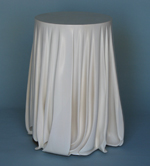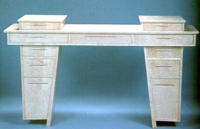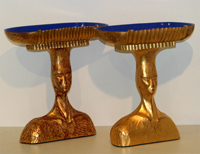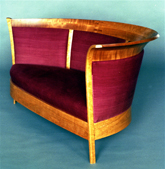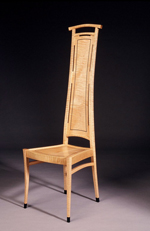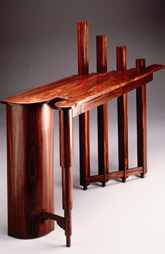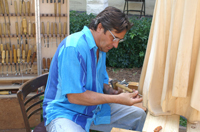
The first thing that caught my eye at James Sagui’s website is a photo of a simple round table covered completely with a white cloth that drapes naturally to the floor. As you might guess, it is not what it seems. In fact, it is wood expertly carved to look like the natural folds of cloth. That’s just one of the varied accomplishments of this woodworker who designs, builds and carves both furniture and wood sculpture in his South Florida shop. But if you want to call James a natural with a chisel, you must admit that at least he came by his talent honestly.
“I first fell in love with woodworking while visiting my father’s best friend’s cabinet shop when I was very little,” James recounted, “but I come from a long line of people who work with their hands. My grandfather was a machinist, and my father worked as a beautician in his own shop. My mother’s parents were both hairdressers, and it was easy for him to get into that business. Being a beautician is a very sculptural profession, not unlike carving wood.
“My mother and three older sisters made all their own clothes. I used to watch them for hours. In retrospect, I realized that the way you build dresses is the same way you build furniture. There are patterns, layout, planning, cutting and assembling in both. Perhaps that, too, was an early influence.
“In school, I was the classic dust hound, and took woodworking through junior high and high school, ” James admitted, invoking yet another common term for what many of us grew up calling a shop rat. “When I was 13, my father, who had always looked covetously at his friend’s woodworking business, changed careers and opened his own cabinet shop. I started working in the shop almost immediately. I sold my first piece, a replica of a bench in my grandfather’s house, when I was 15. I sold it to my sister for 15 dollars. I made some more of the same benches and sold them to others, at slightly higher prices.
“After high school, I got a job in a very low-end table factory. Because I was not yet 18, I could not work on certain machines, so they had me do things like laminating, drilling and sanding. Once I was 18, I realized I could do better, and took a job at an antique restoration and custom furniture shop working under a man who had been trained at Leeds, an industrial design school in England. Most people there had college degrees. After four years rubbing shoulders with highly educated woodworkers, I realized they were no smarter than I, so I started to look for a woodworking school to attend.
“Tage Frid, the late famed woodworking instructor at RISD [Rhode Island School of Design], suggested I study with Jere Osgood at Boston University. I spent four years there majoring in woodworking, then spent a year at a small college overseas in Finland. I ended up actually working there and designing a suite of furniture for the school, and wrote a few articles for a Finnish magazine. I returned to Boston in 1984, started working part-time as a carver for a studio furniture maker, and simultaneously opened my own shop. Five years ago, I moved my shop to Florida.
Today, James runs a custom woodworking shop specializing in carving both sculpture and elements of furniture pieces. “I like carving, especially figures. The carved gothic railing on the web site,” he pointed out, “is part of a spiral staircase. It took 18 months to build and is one of my favorite pieces, mostly because it was such a challenge.”
Today, James runs a custom woodworking shop specializing in carving both sculpture and elements of furniture pieces. “I like carving, especially figures. The carved gothic railing on the web site,” he pointed out, “is part of a spiral staircase. It took 18 months to build and is one of my favorite pieces, mostly because it was such a challenge.”
“The inspiration for the draped table came because I passed the window of a linen shop each day while heading to Starbucks. One day, I noticed the tables in the window with tablecloths draped to the floor, and realized how common an image that is in my area. Where I live, many people close up their homes for the summer and drape the furniture with cloth in a similar manner. Those two things inspired me to carve a pair of trompe l’oeil tables that I called ‘Gone for the Season.’ Both are carved basswood; one is bleached and sealed in water white lacquer, the other natural. Each took 300 hours to carve.
“Another unusual inspiration, a school assignment, resulted in the highback chair. I made it while at school as a seven percent chair, designed to be built in such a way that it was seven percent beyond the breaking point. In other words, it was designed to be very light and delicate. The first one was done in walnut; the one on the web site is a duplicate done in curly maple. A client purchased the maple one specifically to donate it to the Boston Museum of Fine Arts, where it now lives. The first one I have, and a third one was sold to a Long Island architect.”
Though he currently works alone, he had his stint with employees. “In the 90s I took on employees,” he recalls, “usually one person, but as many as three at a time. I did that for a period of seven years. The idea was to get more work produced, but I phased it out when I realized I was spending way too much time telling or teaching others instead of being at the bench. I do this work because I love woodworking, not managing others. These days I work alone and intend to keep it that way. Though I have taught classes in the past, I don’t at present, though I often think about it. There is an aspect of teaching and being able to share what I’ve learned that is gratifying.”
In spite of the high regard his work earns, he is a bit sanguine about the craft. “Woodworking is not something that is a good career choice,” James maintains. “In fact, it is rather stupid in today’s world because it doesn’t really pay very well. It’s smarter to do woodworking as a hobby.”
Why, then, does he do it? “I do it because I must,” he explains, “and I figure if someone, me in this case, is doing something, then they must need to do it.” There is, however, an upside that even he is quick to admit.
“Woodworking is a great thing to do in terms of therapy, satisfaction, challenge and the ability to meet all levels of your needs. It really is worth it to build stuff. It’s just fun.”
